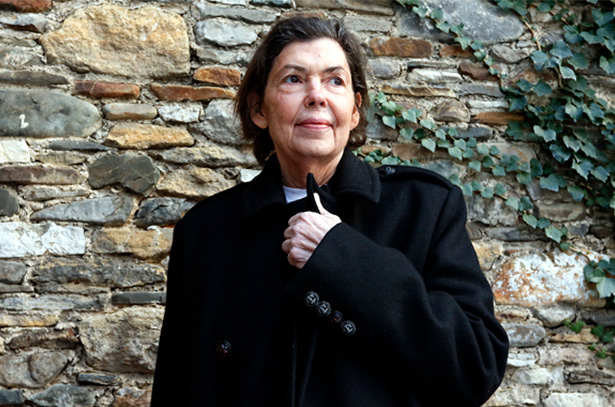
Isa Genzken
15 November - 12 January 2013
London
'I have always said that with any sculpture you have to be able to say, although this is not a ready-made, it could be one. That's what a sculpture has to look like. It must have a certain relation to reality' – Isa Genzken in conversation with Wolfgang Tillmans Inspired by the stark severity of modernist architecture and the chaotic energy of the city, just as much as by art history, the aesthetics of the great American artists of the Sixties and pop culture, Isa Genzken's work is continuously looking around itself, translating into three-dimensional form the way that art, architecture, design and media affects the experience of urban life. From 15 November, Genzken will present an exhibition of new and recent works at Hauser & Wirth's Savile Row gallery. Genzken's totemic columns, pedestal works and collages combine disparate aspects from her many sources in seemingly nonsensical, yet harmonious sculptural compilations. The bust of Nefertiti, an ancient icon of feminine beauty, is one of the most well-known and historically significant sculptures. In Genzken's new series of sculptures, she appropriates plaster reproductions of this bust, which the artist first saw at the Egyptian Museum in Berlin, gives them sunglasses and places them upon tall, white pedestals. She pairs Nefertiti with a reproduction of the Renaissance icon of feminine beauty, the Mona Lisa, whose famous portrait leans against the foot of each pedestal. Genzken then overlays her own self-portrait on to the reproduction of Mona Lisa, playfully inserting herself and her own practice into this multimedia exploration of the lineage of feminine beauty and the place of women in art history. Genzken's sculptures are precariously stacked assemblages of potted plants, designer furniture, empty shipping crates and photographs, among other things, arranged with the traditions of modernist sculpture in mind – traditions which are then manipulated by the artist. With this cacophonous array of objects, Genzken undermines the classical notions of sculpture and, in the North Gallery of Savile Row, re-creates the architectural dimensions of the artist's beloved skyscrapers and the riotous colours of the city streets. Devoid of the weightiness and overpowering scale seen in the sculptures of her Minimalist predecessors, these works abandon notions of order and power, allowing the viewer to relate to the works' inherently human qualities of fragility and vulnerability. Both sculpture and photography combine and overlap in Genzken's collages, whose dense surfaces are formed from the materials of the artist's world: magazines, flyers, snapshots of friends, self-portraits and reproduced artworks. Genzken makes use of all surfaces of the gallery, including an on-going series of collages that span the floor of the space, like a pavement down a busy city street.
Installation views


About the Artist

Isa Genzken
Isa Genzken has long been considered one of Germany’s most important and influential contemporary artists. Born in Bad Oldesloe, Germany, Genzken studied at the renowned Kunstakademie Düsseldorf whose faculty at the time included Joseph Beuys, Bernd and Hilla Becher, Benjamin H.D. Buchloh and Gerhard Richter. Since the 1970s, Genzken’s diverse practice has encompassed sculpture, photography, found-object installation, film, drawing and painting. Her work borrows from the aesthetics of Minimalism, punk culture and assemblage art to confront the conditions of human experience in contemporary society and the uneasy social climate of capitalism.Genzken is best known for her sculptures, gaining attention for her minimalist oriented Hyperbolos and Ellipsoids in the late 70s, and architecturally-inflected works such as her recent epoxy resin windows and skyscraper Columns from the 90s. Genzken’s practice is incredibly wide-ranging, but her work remains dedicated to challenging the viewer’s self-awareness by means of physically altering their perceptions, bringing bodies together in spaces and integrating elements of a mixed media into sculpture.
Genzken’s totemic columns, pedestal works and collages combine disparate aspects from her many sources in seemingly nonsensical, yet harmonious sculptural compilations. These sculptures take the form of precariously stacked assemblages of potted plant designer furniture, empty shipping crates and photographs, among other things, arranged with the traditions of modernist sculpture in mind. With this cacophonous array of objects, Genzken undermines the classical notions of sculpture, re-creating the architectural dimensions of her beloved skyscrapers and the riotous colors of the city streets. Devoid of the weightiness and overpowering scale seen in the sculptures of her Minimalist predecessors, her work abandons notions of order and power, allowing the viewer to relate to the works’ inherently human qualities of fragility and vulnerability.
Inspired by the stark severity of modernist architecture and the chaotic energy of the city, Genzken’s work is continuously looking around itself, translating into three-dimensional form the way that art, architecture, design and media affects the experience of urban life, and the divides between public and private. There is an intuitive and consistent manner to Genzken’s work, not only in dramatising aspects of space and scale for the audience, but in creating new dialogues and contact with surfaces of material. The socio-political content is evident and central to her oeuvre.
In 2017, Genzken was awarded the prestigious Goslarer Kaiserring (or Emperor’s Ring) by the city of Goslar, Germany.
Current Exhibitions
1 / 12



































